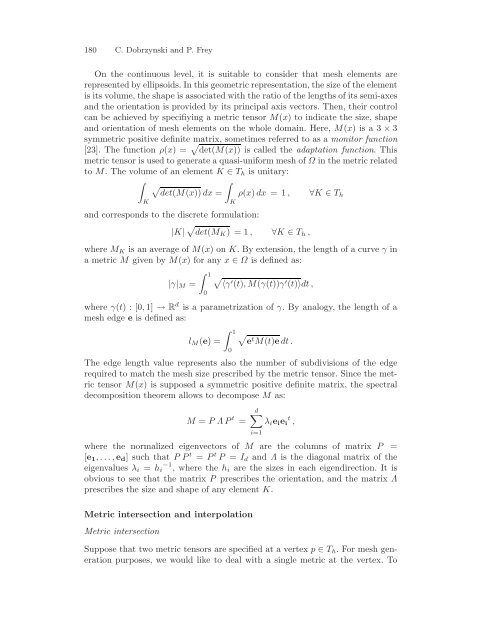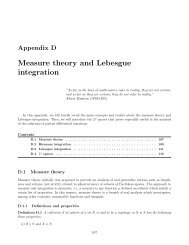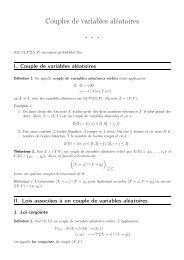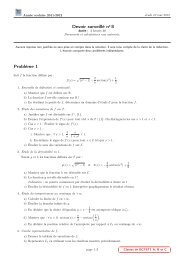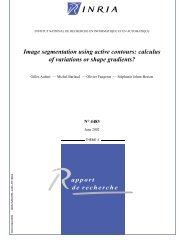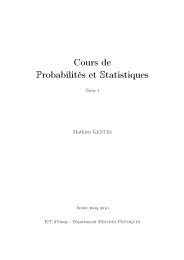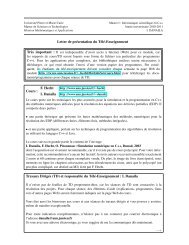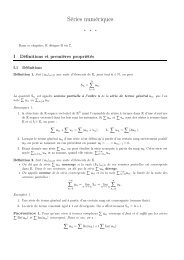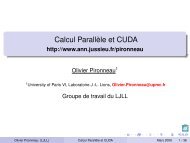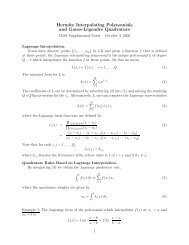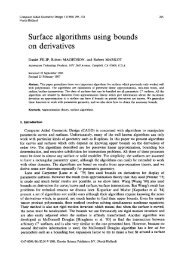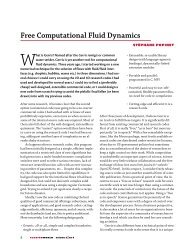Anisotropic Delaunay Mesh Adaptation for Unsteady Simulations
Anisotropic Delaunay Mesh Adaptation for Unsteady Simulations
Anisotropic Delaunay Mesh Adaptation for Unsteady Simulations
Create successful ePaper yourself
Turn your PDF publications into a flip-book with our unique Google optimized e-Paper software.
180 C. Dobrzynski and P. Frey<br />
On the continuous level, it is suitable to consider that mesh elements are<br />
represented by ellipsoids. In this geometric representation, the size of the element<br />
is its volume, the shape is associated with the ratio of the lengths of its semi-axes<br />
and the orientation is provided by its principal axis vectors. Then, their control<br />
can be achieved by specifiying a metric tensor M(x) to indicate the size, shape<br />
and orientation of mesh elements on the whole domain. Here, M(x) isa3 × 3<br />
symmetric positive definite matrix, sometimes referred to as a monitor function<br />
[23]. The function ρ(x) = √ det(M(x)) is called the adaptation function. This<br />
metric tensor is used to generate a quasi-uni<strong>for</strong>m mesh of Ω in the metric related<br />
to M. The volume of an element K ∈ T h isunitary:<br />
∫<br />
√<br />
∫<br />
det(M(x)) dx = ρ(x) dx =1, ∀K ∈ T h<br />
K<br />
and corresponds to the discrete <strong>for</strong>mulation:<br />
K<br />
|K| √ det(M K ) = 1 , ∀K ∈ T h ,<br />
where M K isan average of M(x) on K. By extension, the length of a curve γ in<br />
a metric M given by M(x) <strong>for</strong> any x ∈ Ω is defined as:<br />
|γ| M =<br />
∫ 1<br />
0<br />
√<br />
〈γ′ (t),M(γ(t))γ ′ (t)〉dt ,<br />
where γ(t) : [0, 1] → R d is a parametrization of γ. By analogy, the length of a<br />
mesh edge e is defined as:<br />
l M (e) =<br />
∫ 1<br />
0<br />
√<br />
et M(t)e dt .<br />
The edge length value represents also the number of subdivisions of the edge<br />
required to match the mesh size prescribed by the metric tensor. Since the metric<br />
tensor M(x) is supposed a symmetric positive definite matrix, the spectral<br />
decomposition theorem allows to decompose M as:<br />
M = P Λ P t =<br />
d∑<br />
λ i e i e t i ,<br />
where the normalized eigenvectors of M are the columns of matrix P =<br />
[e 1 ,...,e d ] such that PP t = P t P = I d and Λ is the diagonal matrix of the<br />
eigenvalues λ i = h i −1 ,where the h i are the sizes in each eigendirection. It is<br />
obvious to see that the matrix P prescribes the orientation, and the matrix Λ<br />
prescribes the size and shape of any element K.<br />
Metric intersection and interpolation<br />
Metric intersection<br />
Suppose that two metric tensors are specified at a vertex p ∈ T h . For mesh generation<br />
purposes, we would like to deal with a single metric at the vertex. To<br />
i=1


